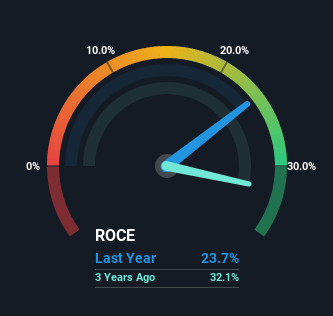Robert Walters (LON:RWA) Is Reinvesting To Multiply In Value
If you're looking for a multi-bagger, there's a few things to keep an eye out for. Typically, we'll want to notice a trend of growing return on capital employed (ROCE) and alongside that, an expanding base of capital employed. Basically this means that a company has profitable initiatives that it can continue to reinvest in, which is a trait of a compounding machine. Ergo, when we looked at the ROCE trends at Robert Walters (LON:RWA), we liked what we saw.
What is Return On Capital Employed (ROCE)?
If you haven't worked with ROCE before, it measures the 'return' (pre-tax profit) a company generates from capital employed in its business. Analysts use this formula to calculate it for Robert Walters:
Return on Capital Employed = Earnings Before Interest and Tax (EBIT) ÷ (Total Assets - Current Liabilities)
0.24 = UK£54m ÷ (UK£446m - UK£218m) (Based on the trailing twelve months to December 2021).
So, Robert Walters has an ROCE of 24%. That's a fantastic return and not only that, it outpaces the average of 13% earned by companies in a similar industry.
See our latest analysis for Robert Walters
In the above chart we have measured Robert Walters' prior ROCE against its prior performance, but the future is arguably more important. If you'd like to see what analysts are forecasting going forward, you should check out our free report for Robert Walters.
The Trend Of ROCE
In terms of Robert Walters' history of ROCE, it's quite impressive. The company has employed 119% more capital in the last five years, and the returns on that capital have remained stable at 24%. With returns that high, it's great that the business can continually reinvest its money at such appealing rates of return. If these trends can continue, it wouldn't surprise us if the company became a multi-bagger.
One more thing to note, even though ROCE has remained relatively flat over the last five years, the reduction in current liabilities to 49% of total assets, is good to see from a business owner's perspective. This can eliminate some of the risks inherent in the operations because the business has less outstanding obligations to their suppliers and or short-term creditors than they did previously. Although because current liabilities are still 49%, some of that risk is still prevalent.
What We Can Learn From Robert Walters' ROCE
In summary, we're delighted to see that Robert Walters has been compounding returns by reinvesting at consistently high rates of return, as these are common traits of a multi-bagger. However, over the last five years, the stock has only delivered a 36% return to shareholders who held over that period. That's why it could be worth your time looking into this stock further to discover if it has more traits of a multi-bagger.
If you want to know some of the risks facing Robert Walters we've found 3 warning signs (1 makes us a bit uncomfortable!) that you should be aware of before investing here.
If you'd like to see other companies earning high returns, check out our free list of companies earning high returns with solid balance sheets here.
Have feedback on this article? Concerned about the content? Get in touch with us directly. Alternatively, email editorial-team (at) simplywallst.com.
This article by Simply Wall St is general in nature. We provide commentary based on historical data and analyst forecasts only using an unbiased methodology and our articles are not intended to be financial advice. It does not constitute a recommendation to buy or sell any stock, and does not take account of your objectives, or your financial situation. We aim to bring you long-term focused analysis driven by fundamental data. Note that our analysis may not factor in the latest price-sensitive company announcements or qualitative material. Simply Wall St has no position in any stocks mentioned.

